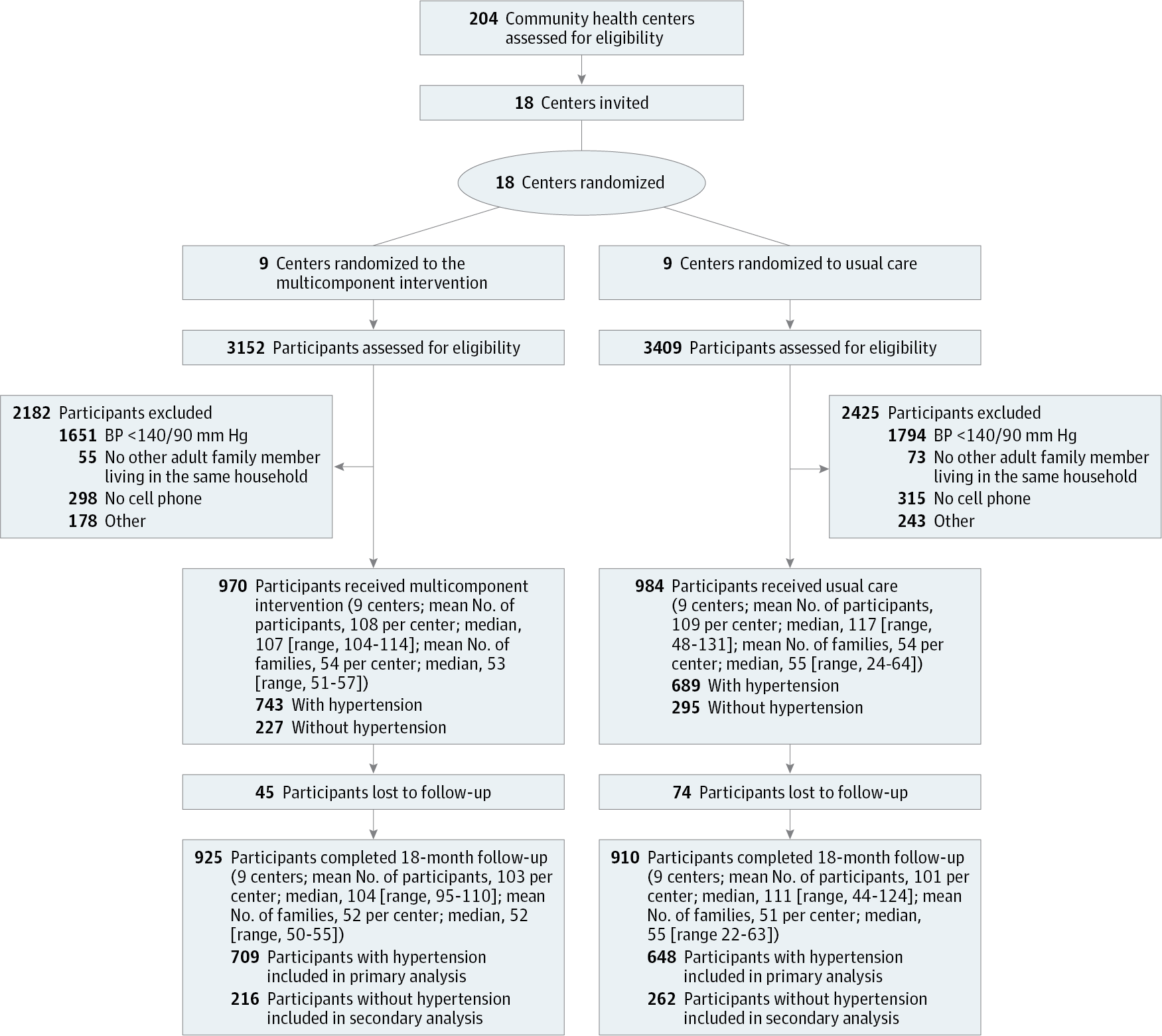Our official English website, www.x-mol.net, welcomes your feedback! (Note: you will need to create a separate account there.)
Effect of a Community Health Worker–Led Multicomponent Intervention on Blood Pressure Control in Low-Income Patients in Argentina
JAMA ( IF 120.7 ) Pub Date : 2017-09-19 , DOI: 10.1001/jama.2017.11358 Jiang He 1 , Vilma Irazola 2 , Katherine T. Mills 3 , Rosana Poggio 2 , Andrea Beratarrechea 2 , Jacquelyn Dolan 4 , Chung-Shiuan Chen 3 , Luz Gibbons 2 , Marie Krousel-Wood 1 , Lydia A. Bazzano 3 , Analia Nejamis 2 , Pablo Gulayin 2 , Marilina Santero 2 , Federico Augustovski 2 , Jing Chen 1 , Adolfo Rubinstein 2 ,
JAMA ( IF 120.7 ) Pub Date : 2017-09-19 , DOI: 10.1001/jama.2017.11358 Jiang He 1 , Vilma Irazola 2 , Katherine T. Mills 3 , Rosana Poggio 2 , Andrea Beratarrechea 2 , Jacquelyn Dolan 4 , Chung-Shiuan Chen 3 , Luz Gibbons 2 , Marie Krousel-Wood 1 , Lydia A. Bazzano 3 , Analia Nejamis 2 , Pablo Gulayin 2 , Marilina Santero 2 , Federico Augustovski 2 , Jing Chen 1 , Adolfo Rubinstein 2 ,
Affiliation

|
Importance Despite extensive knowledge of hypertension treatment, the prevalence of uncontrolled hypertension is high and increasing in low- and middle-income countries. Objective To test whether a community health worker–led multicomponent intervention would improve blood pressure (BP) control among low-income patients with hypertension. Design, Setting, and Participants A cluster randomized trial was conducted in 18 centers for primary health care within a national public system providing free medications and health care to uninsured patients in Argentina. A total of 1432 low-income adult patients with uncontrolled hypertension were recruited between June 2013 and April 2015 and followed up to October 2016. Interventions Nine centers (743 patients) were randomized to the multicomponent intervention, which included a community health worker–led home intervention (health coaching, home BP monitoring, and BP audit and feedback), a physician intervention, and a text-messaging intervention over 18 months. Nine centers (689 patients) were randomized to usual care. Main Outcomes and Measures The coprimary outcomes were the differences in systolic and diastolic BP changes from baseline to the end of follow-up of patients with hypertension. Secondary outcomes included the proportion of patients with controlled hypertension (BP <140/90 mm Hg). Three BP measurements were obtained at each of 2 baseline and 2 termination visits using a standard protocol, the means of which were used for analyses. Results Of 1432 participants (mean age, 55.8 years [SD, 13.3]; 772 women [53.0%]), 1357 (94.8%) completed the trial. Baseline mean systolic BP was 151.7 mm Hg for the intervention group and 149.8 mm Hg for the usual care group; the mean diastolic BP was 92.2 mm Hg for the intervention group and 90.1 mm Hg for the usual care group. Systolic BP reduction from baseline to month 18 was 19.3 mm Hg (95% CI, 17.9-20.8 mm Hg) for the intervention group and 12.7 mm Hg (95% CI, 11.3-14.2 mm Hg) for the usual care group; the difference in the reduction was 6.6 mm Hg (95% CI, 4.6-8.6; P < .001). Diastolic BP decreased by 12.2 mm Hg (95% CI, 11.2-13.2 mm Hg) in the intervention group and 6.9 mm Hg (95% CI, 5.9-7.8 mm Hg) in the control group; the difference in the reduction was 5.4 mm Hg (95% CI, 4.0-6.8 mm Hg; P < .001). The proportion of patients with controlled hypertension increased from 17.0% at baseline to 72.9% at 18 months in the intervention group and from 17.6% to 52.2% in the usual care group; the difference in the increase was 20.6% (95% CI, 15.4%-25.9%; P < .001). No adverse events were reported. Conclusions and Relevance Low-income patients in Argentina with uncontrolled hypertension who participated in a community health worker–led multicomponent intervention experienced a greater decrease in systolic and diastolic BP than did patients who received usual care over 18 months. Further research is needed to assess generalizability and cost-effectiveness of this intervention and to understand which components may have contributed most to the outcome. Trial Registration clinicaltrials.gov Identifier: NCT01834131
中文翻译:

社区卫生工作者主导的多元干预对阿根廷低收入患者血压控制的影响
重要性 尽管对高血压治疗有广泛的了解,但在低收入和中等收入国家,不受控制的高血压患病率很高,而且还在增加。目的 测试社区卫生工作者主导的多组分干预是否会改善低收入高血压患者的血压 (BP) 控制。设计、设置和参与者 一项整群随机试验在国家公共系统内的 18 个初级卫生保健中心进行,为阿根廷未参保的患者提供免费药物和卫生保健。2013 年 6 月至 2015 年 4 月期间共招募了 1432 名患有未控制高血压的低收入成年患者,随访至 2016 年 10 月。 干预 九个中心(743 名患者)随机接受多组分干预,其中包括社区卫生工作者主导的家庭干预(健康指导、家庭血压监测以及血压审计和反馈)、医生干预和超过 18 个月的短信干预。九个中心(689 名患者)随机接受常规治疗。主要结果和措施 共同主要结果是高血压患者从基线到随访结束时收缩压和舒张压变化的差异。次要结果包括控制高血压(BP <140/90 mm Hg)的患者比例。使用标准方案在 2 次基线和 2 次终止访问中的每一次获得三个 BP 测量值,其平均值用于分析。结果 在 1432 名参与者(平均年龄,55.8 岁 [SD,13.3];772 名女性 [53.0%])中,1357 名 (94.8%) 完成了试验。基线平均收缩压为 151。干预组为 7 毫米汞柱,常规护理组为 149.8 毫米汞柱;干预组的平均舒张压为 92.2 毫米汞柱,常规护理组为 90.1 毫米汞柱。干预组从基线到第 18 个月的收缩压降低为 19.3 mm Hg(95% CI,17.9-20.8 mm Hg),常规护理组降低 12.7 mm Hg(95% CI,11.3-14.2 mm Hg);减少的差异为 6.6 毫米汞柱(95% CI,4.6-8.6;P < .001)。干预组舒张压降低 12.2 mm Hg(95% CI,11.2-13.2 mm Hg),对照组降低 6.9 mm Hg(95% CI,5.9-7.8 mm Hg);减少的差异为 5.4 毫米汞柱(95% CI,4.0-6.8 毫米汞柱;P < .001)。干预组高血压得到控制的患者比例从基线时的 17.0% 增加到 18 个月时的 72.9%,从 17.6% 增加到 52。常规护理组 2%;增加的差异为 20.6%(95% CI,15.4%-25.9%;P < .001)。没有报告不良事件。结论和相关性 阿根廷的低收入高血压患者参与社区卫生工作者主导的多组分干预,其收缩压和舒张压下降幅度大于接受常规治疗 18 个月以上的患者。需要进一步研究来评估这种干预措施的普遍性和成本效益,并了解哪些成分可能对结果的贡献最大。试验注册clinicaltrials.gov 标识符:NCT01834131 结论和相关性 阿根廷的低收入高血压患者参与社区卫生工作者主导的多组分干预,其收缩压和舒张压下降幅度大于接受常规治疗 18 个月以上的患者。需要进一步研究来评估这种干预措施的普遍性和成本效益,并了解哪些成分可能对结果的贡献最大。试验注册clinicaltrials.gov 标识符:NCT01834131 结论和相关性 阿根廷的低收入高血压患者参与社区卫生工作者主导的多组分干预,其收缩压和舒张压下降幅度大于接受常规治疗 18 个月以上的患者。需要进一步研究来评估这种干预措施的普遍性和成本效益,并了解哪些成分可能对结果的贡献最大。试验注册clinicaltrials.gov 标识符:NCT01834131 需要进一步研究来评估这种干预措施的普遍性和成本效益,并了解哪些成分可能对结果的贡献最大。试验注册clinicaltrials.gov 标识符:NCT01834131 需要进一步研究来评估这种干预措施的普遍性和成本效益,并了解哪些成分可能对结果的贡献最大。试验注册clinicaltrials.gov 标识符:NCT01834131
更新日期:2017-09-19
中文翻译:

社区卫生工作者主导的多元干预对阿根廷低收入患者血压控制的影响
重要性 尽管对高血压治疗有广泛的了解,但在低收入和中等收入国家,不受控制的高血压患病率很高,而且还在增加。目的 测试社区卫生工作者主导的多组分干预是否会改善低收入高血压患者的血压 (BP) 控制。设计、设置和参与者 一项整群随机试验在国家公共系统内的 18 个初级卫生保健中心进行,为阿根廷未参保的患者提供免费药物和卫生保健。2013 年 6 月至 2015 年 4 月期间共招募了 1432 名患有未控制高血压的低收入成年患者,随访至 2016 年 10 月。 干预 九个中心(743 名患者)随机接受多组分干预,其中包括社区卫生工作者主导的家庭干预(健康指导、家庭血压监测以及血压审计和反馈)、医生干预和超过 18 个月的短信干预。九个中心(689 名患者)随机接受常规治疗。主要结果和措施 共同主要结果是高血压患者从基线到随访结束时收缩压和舒张压变化的差异。次要结果包括控制高血压(BP <140/90 mm Hg)的患者比例。使用标准方案在 2 次基线和 2 次终止访问中的每一次获得三个 BP 测量值,其平均值用于分析。结果 在 1432 名参与者(平均年龄,55.8 岁 [SD,13.3];772 名女性 [53.0%])中,1357 名 (94.8%) 完成了试验。基线平均收缩压为 151。干预组为 7 毫米汞柱,常规护理组为 149.8 毫米汞柱;干预组的平均舒张压为 92.2 毫米汞柱,常规护理组为 90.1 毫米汞柱。干预组从基线到第 18 个月的收缩压降低为 19.3 mm Hg(95% CI,17.9-20.8 mm Hg),常规护理组降低 12.7 mm Hg(95% CI,11.3-14.2 mm Hg);减少的差异为 6.6 毫米汞柱(95% CI,4.6-8.6;P < .001)。干预组舒张压降低 12.2 mm Hg(95% CI,11.2-13.2 mm Hg),对照组降低 6.9 mm Hg(95% CI,5.9-7.8 mm Hg);减少的差异为 5.4 毫米汞柱(95% CI,4.0-6.8 毫米汞柱;P < .001)。干预组高血压得到控制的患者比例从基线时的 17.0% 增加到 18 个月时的 72.9%,从 17.6% 增加到 52。常规护理组 2%;增加的差异为 20.6%(95% CI,15.4%-25.9%;P < .001)。没有报告不良事件。结论和相关性 阿根廷的低收入高血压患者参与社区卫生工作者主导的多组分干预,其收缩压和舒张压下降幅度大于接受常规治疗 18 个月以上的患者。需要进一步研究来评估这种干预措施的普遍性和成本效益,并了解哪些成分可能对结果的贡献最大。试验注册clinicaltrials.gov 标识符:NCT01834131 结论和相关性 阿根廷的低收入高血压患者参与社区卫生工作者主导的多组分干预,其收缩压和舒张压下降幅度大于接受常规治疗 18 个月以上的患者。需要进一步研究来评估这种干预措施的普遍性和成本效益,并了解哪些成分可能对结果的贡献最大。试验注册clinicaltrials.gov 标识符:NCT01834131 结论和相关性 阿根廷的低收入高血压患者参与社区卫生工作者主导的多组分干预,其收缩压和舒张压下降幅度大于接受常规治疗 18 个月以上的患者。需要进一步研究来评估这种干预措施的普遍性和成本效益,并了解哪些成分可能对结果的贡献最大。试验注册clinicaltrials.gov 标识符:NCT01834131 需要进一步研究来评估这种干预措施的普遍性和成本效益,并了解哪些成分可能对结果的贡献最大。试验注册clinicaltrials.gov 标识符:NCT01834131 需要进一步研究来评估这种干预措施的普遍性和成本效益,并了解哪些成分可能对结果的贡献最大。试验注册clinicaltrials.gov 标识符:NCT01834131



























 京公网安备 11010802027423号
京公网安备 11010802027423号